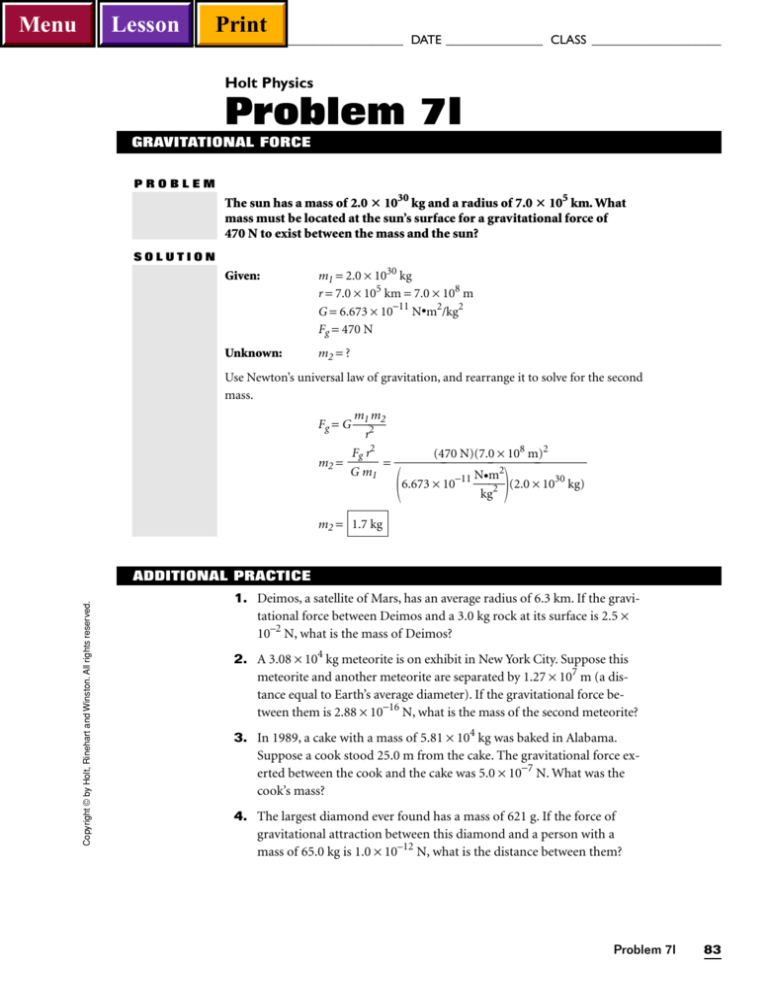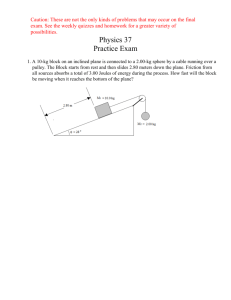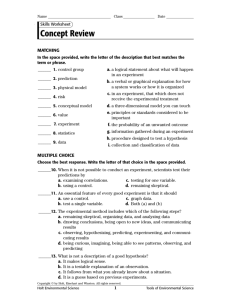
Lesson
Menu
Print
NAME ______________________________________ DATE _______________ CLASS ____________________
Holt Physics
Problem 7I
GRAVITATIONAL FORCE
PROBLEM
The sun has a mass of 2.0 1030 kg and a radius of 7.0 105 km. What
mass must be located at the sun’s surface for a gravitational force of
470 N to exist between the mass and the sun?
SOLUTION
Given:
m1 = 2.0 × 1030 kg
r = 7.0 × 105 km = 7.0 × 108 m
G = 6.673 × 10−11 N•m2/kg2
Fg = 470 N
Unknown:
m2 = ?
Use Newton’s universal law of gravitation, and rearrange it to solve for the second
mass.
m m2
Fg = G 1
r2
Fg r2
(470 N)(7.0 × 108 m)2
m2 = =
G m1
N•m2
30
6.673 × 10−11
2 (2.0 × 10 kg)
kg
m2 = 1.7 kg
Copyright © by Holt, Rinehart and Winston. All rights reserved.
ADDITIONAL PRACTICE
1. Deimos, a satellite of Mars, has an average radius of 6.3 km. If the gravitational force between Deimos and a 3.0 kg rock at its surface is 2.5 ×
10–2 N, what is the mass of Deimos?
2. A 3.08 × 104 kg meteorite is on exhibit in New York City. Suppose this
meteorite and another meteorite are separated by 1.27 × 107 m (a distance equal to Earth’s average diameter). If the gravitational force between them is 2.88 × 10−16 N, what is the mass of the second meteorite?
3. In 1989, a cake with a mass of 5.81 × 104 kg was baked in Alabama.
Suppose a cook stood 25.0 m from the cake. The gravitational force exerted between the cook and the cake was 5.0 × 10−7 N. What was the
cook’s mass?
4. The largest diamond ever found has a mass of 621 g. If the force of
gravitational attraction between this diamond and a person with a
mass of 65.0 kg is 1.0 × 10–12 N, what is the distance between them?
Problem 7I
83
Menu
Lesson
Print
NAME ______________________________________ DATE _______________ CLASS ____________________
5. The passenger liners Carnival Destiny and Grand Princess, built recently, have a mass of about 1.0 × 108 kg each. How far apart must
these two ships be to exert a gravitational attraction of 1.0 × 10−3 N on
each other?
6. In 1874, a swarm of locusts descended on Nebraska. The swarm’s mass
was estimated to be 25 × 109 kg. If this swarm were split in half and the
halves separated by 1.0 × 103 km, what would the magnitude of the
gravitational force between the halves be?
Copyright © by Holt, Rinehart and Winston. All rights reserved.
7. Jupiter, the largest planet in the solar system, has a mass 318 times that
of Earth and a volume that is 1323 times greater than Earth’s. Calculate
the magnitude of the gravitational force exerted on a 50.0 kg mass on
Jupiter’s surface.
84
Holt Physics Problem Workbook
Menu
Lesson
Print
Givens
Solutions
Fg = Fc
3. vt = 8.1 m/s
m vt2
m1g = 2
r
r = 4.23 m
m1 = 25 g
m gr
m2 = 1
vt2
g = 9.81 m/s2
(25 × 10−3 kg)(9.81 m/s2)(4.23 m)
m2 =
= 1.6 × 10−2 kg
(8.1 m/s)2
v2
Fc = m t
r
4. vt = 75.57 km/h
m = 92.0 kg
(92.0 kg)[(75.57 km/h)(103 m/km)(1 h/3600 s)]2
mvt2
r =
=
12.8 N
Fc
Fc = 12.8 N
r = 3.17 × 103 m = 3.17 km
5. m = 75.0 kg
II
mvt 2 (75.0 kg)(12 m/s)2
Fc =
= = 24 N
446 m
r
r = 446 m
vt = 12 m/s
FT = Fc + mg = 24 N + (75.0 kg)(9.81 m/s2)
2
g = 9.81 m/s
FT = 24 N + 736 N = 7.60 × 102 N
Additional Practice 7I
1. r = 6.3 km
Fgr
(2.5 × 10−2 N)(6.3 × 103 m)2
m2 = =
Gm1
N • m2
6.673 × 10−11
(3.0 kg)
kg 2
2
N
m1 = 3.0 kg
N•m2
G = 6.673 × 10−11
kg2
2. m1 = 3.08 × 104 kg
m2 = 5.0 × 1015 kg
Fgr2
(2.88 × 10−16 N)(1.27 × 107 m)2
m2 = =
Gm1
N • m2
6.673 × 10−11
(3.08 × 104 kg)
kg 2
7
r = 1.27 × 10 m
Fg = 2.88 × 10−16 N
2
N•m
G = 6.673 × 10−11
kg2
3. m1 = 5.81 × 104 kg
r = 25.0 m
Fg = 5.00 × 10−7 N
N•m2
G = 6.673 × 10−11
kg2
II Ch. 7–8
m2 = 2.26 × 104 kg
Fgr2
(5.00 × 10−7 N)(25.0 m)2
m2 = =
Gm1
N • m2
6.673 ×10−11
(5.81 × 104 kg)
kg 2
m2 = 80.6 kg
Holt Physics Solution Manual
Copyright © by Holt, Rinehart and Winston. All rights reserved.
Fg = 2.5 × 10
−2
Menu
Lesson
Print
Givens
Solutions
4. m1 = 621 g
r=
m2 = 65.0 kg
N•m2
G = 6.673 × 10−11
kg2
5. m1 = m2 = 1.0 × 108 kg
Fg = 1.0 × 10
N
−11
G = 6.673 × 10
Gm1m2
g
Fg = 1.0 × 10−12 N
−3
F
N•m2
kg2
(6.673 × 10−11 N • m2/kg2)(0.621 kg)(65.0 kg)
r=
= 52 m
1.0 × 10 N
r=
F
−12
Gm1m2
g
r=
(6.673 × 10−11 N • m2/kg2)(1.0 × 108 kg)2
1.0 × 10−3 N
r = 2.6 × 104 m = 26 km
6. ms = 25 × 109 kg
m1 = m2 =
1
m
2 s
3
r = 1.0 × 10 km
N•m2
G = 6.673 × 10−11
kg2
7. m1 = 318mE
m2 = 50.0 kg
VJ = 1323VE
mE = 5.98 × 1024 kg
rE = 6.37 × 106 m
N • m2 1
6.673 × 10−11
(25 × 109 kg)2
kg2 2
Gm1m2
Fg =
=
= 1.0 × 10−2 N
(1.0 × 106 m)2
r2
II
If VJ = 1323 VE , then rJ = 3 1323
rE .
Gm m2 (6.673 × 10−11 N • m2/kg2)(318)(5.98 × 1024 kg)(50.0 kg)
Fg = 1
=
rJ 2
[( 3 13
23
)(6.37 × 106 m)]2
Fg = 1.30 × 103 N
Copyright © by Holt, Rinehart and Winston. All rights reserved.
N•m2
G = 6.673 × 10−11
kg2
Section Two—Problem Workbook Solutions
II Ch. 7–9










